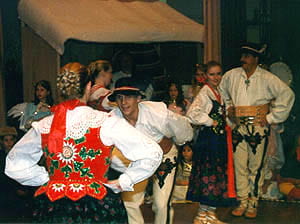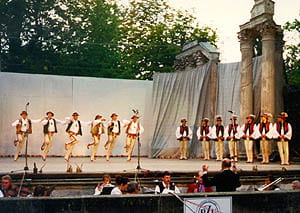Essay by Maja Trochimczyk
History
The góralski is one of the two basic dances of the Skalne Podhale region (Rocky Foothills of the Tatra Mountains in southern Poland). The góralski and zbójnicki do not occur in the neighboring mountains of Pieniny and Beskidy, and the districts of Orawa and Spisz. The góralski is a general name of the solo dance of one couple who perform a series of dances (3-8). In each segment of the dance, the male dancer sings a selected tune (nuta) in a freely structured rhythm. The ensemble of musicians picks up this tune and performs it for the couple to dance to.

The góralski varies in content and style from one village to another and from one dancer to another. Although the góralski is a couple dance, the partners touch only during the final turning together figure, called “zwyrtanie” (according to Ada Dziewanowska, Polish Folk Songs and Dances, p. 267). The man plays the leading role and performs the most intricate steps. The woman has only two or three different patterns to perform and mostly responds to the actions of the man.
There were few transcriptions of górale music in the first half of the 19th century and none earlier; an explosive growth in the outsiders’ interest began in the late 19th century. At that time, Dr. Tytus Chałubiński organized many excursions into the Tatras accompanied by groups of górale musicians. Despite the presence of górale themes in 19th-century Polish opera (Karol Kurpiński’s Zabobon, czyli krakowiacy i górale; Stanisław Moniuszko’s Halka), a serious interest in the stylistic traits of the Podhale folklore was expressed only in the 20th century, starting with Karol Szymanowski (his Mazurkas, ballet Harnasie), and continuing with Artur Malawski (symphonic poem Tatry), Henryk Górecki (two string quartets), and Wojciech Kilar (Krzesany for symphony orchestra).
Description
The dance is performed by a solo couple; the man is the dominant partner and selects the tunes and figures to perform. He sings to te musicians the tune he wants to dance and they respond by repeating it with ornaments. According to the description of the góralski by Włodzimierz Kotoński, the dance begins when another male dancers introduces the girl onto the dance floor and turns her around (“Wyzwyrtanie”). During the following sequence of dances, the male partner dances solo, circling around the woman and presenting a variety of figures. The woman responds by turning, performing heel clicks, and stamping. The dance sequence usually begins with the slower nuta ozwodna and the steps of drobiony (minced), running, and regular. After a couple of ozwodnas the dancers performs a krzesany (from “sparks” of the flint; the name comes from the regular, heavy accents in the music) or drobny (tiny; the name reflects the small size of the fast-paced steps).

Elaborate figures include hitting the sides and feet with hands, jumps on one or both feet, high jumps (usually with bended knees). At the end, the dancers perform to the nuta zielona (green); only in this part do they touch and turn together (zwyrtanie). After one couple finished their dance another couple may begin; the others watch their performance. The exact number of the particular dances in each segment differs, depending entirely on the fancy of the male dancer.
According to Ada Dziewanowska (Polish Folk Songs and Dances, 268) “the góralski is not an easy dance to learn. The basic technical execution of the steps is one problem. The style is another, even greater, problem. It is hard to imitate and impossible to perfect (unless you happen to have been born and raised in Podhale).” In the dance, the leg movements are small. The most important concept for both the man and woman is that you should have as little movement as possible from the waist upward, especially up and down motion. All movements of the legs should be absorbed by the knees which are always slightly bent.

Since the dance is of an improvisatory nature and consists of a series of performances by single couples, each occupying the whole floor, it is hard to adapt this dance to a stage performance by a folk dance ensemble. Dziewanowska suggests adding segments for the women only, dancing in a circle somewhere in the back. Large folk dance groups often enrich the dance by introducing segments for the men who perform complicated figures simultaneously, placed in a line (see the performance by Mazowsze, 1997).
This stage position originates from Balkan dances, while some of the more impressive jumps are of Russian origin. Such spectacular elements were added to the dances by choreographers of the State Folk Dance Ensembles in order to enrich the theatricality of the spectacle. Another option, also introduced by the large state dance ensembles is to connect a series of dances and songs in a suite from a certain area. Such a set from Limanowa is performed by youth group of Podhale Polish Folk Dance Company (see the photo below in the costume section).
Costumes
The male dancers wear black felt hats with a band of seashells and a feather, white shirts with broad sleeves, thick and richly adorned leather belts, and white wool pants with the parzenica patterns (for more information about the costumes see the entry on zbónicki). Both men and women wear leather shoes with pressed-in ornaments, called the kierpce.
The women’s costumes are more colorful than the men’s. Their wool skirts have flowery patterns of roses on green, red, or white background (white is used only for weddings). They wear white shirts finished with lace, tight ornamental vests reaching just below their waistlines, and strings of coral beads on their necks. The vests are tied with ribbons; the women also wear braids with colorful ribbons in their hair.
Music
Podhale is the only area of Poland where the folk culture is still alive as it is present in the daily activities of the górale. They wear their costumes, speak the local dialect, and sing and play the traditional melodies. The music of this region strongly differs from Polish folk music of its northern regions, especially because of its predominantly duple meters (triple meter is the most popular on the Mazovian plains). However, Timothy Cooley discovered that the 19th century collectors, especially Oskar Kolberg, found numerous triple-meter melodies in the Tatras; the change of the repertoire may be attributed to the influence of outsiders, the tourism promoters and ethnographers, who emphasized the differences between the music of the górale and that originating from the rest of the country (Cooley 1998, 2000).
Several types of melodies are used for the dance: nuta ozwodna, krzesana, drobna, and zielona. The man sings one couplet in a high and tense falsetto voice and a quasi-improvisatory manner. The band (called kapela or muzyka), led by a violinist, responds with repeats of the ornamented melody (performed by lead violinist). The strongly accented rhythmic foundation is provided by the accompanying violins and the basy (see the entry on zbójnicki for a description of the band and the instruments).
Sources of Material
- Cooley, Timothy, J. “Constructing an “Authentic” Folk Music of the Polish Tatras,” in Maja Trochimczyk, ed. After Chopin: Essays in Polish Music. Los Angeles: Friends of Polish Music, 2000, 243-262.
- Cooley, Timothy, J. “Authentic Troupes and Inauthentic Tropes: Performance Practice in Górale Music,” Polish Music Journal 1 no. 1 (1998), ../PMJ/index.html
- Dziewanowska, Ada. Polish Folk Dances & Songs – a Step by Step Guide (New York: Hippocrene Books, 1999).
- Cooley, Timothy: Notes for Fire in the Mountains CD of archival recordings by various highland bands (1927-1950). Yazoo 7013, 1997.
- Harley, Maria Anna. “Dance as a National Symbol: Polish Dance in Southern California” Project for Southern California Studies Center at USC, August 2000.
- Kotoński, Włodzimierz. Góralski i zbójnicki. Kraków: PWM, 1956.
- Notes for Sources of Polish Folk Music / Muzyka Źródeł, vol. 2, Podhale; Polskie Radio CD PRCD 151, 1996.
- “Zbójnictwo,” entry in Słownik Folkloru Polskiego (Dictionary of Polish Folklore) Julian Krzyżanowski, ed. Warszawa: Wiedza Powszechna, 1965.
Illustrations from Polish folk art (straw cutouts); photographs from PMC Collection and from archival material gathered for M.A. Harley’s Polish Dance in Southern California project.
